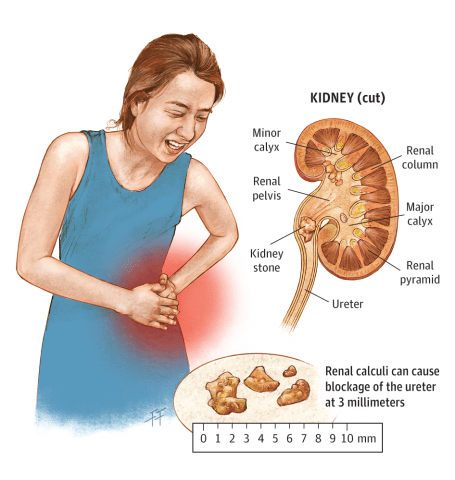Kidney stone, which is also called renal calculus, is a firm, crystalline mineral material formed within the kidneys urinary tract and it becomes so huge that it impairs usual renal functions.
There are certain circumstances where there is increase in the likelihood of stone formation, either by reduction in fluid volume or increase in mineral concentration that can be enough to disrupt the delicate balance between the liquid and its solute.
According to studies, the incidence of renal stones increases day by day. This is mostly due to changes in diet, lifestyle, obesity etc.
A survey done by National Health and Nutrition Examination, shows 10.6 per cent of men and 7.1 per cent of women are reported with renal stones.
This also depicts that obesity and age are contributing factors. Other risk factors included:
- Hypertension;
- High protein diet;
- Low fluid intake;
- Increase intake of vitamin C and D supplements;
- Drinking fluoridated water may increase risk; and
- Frequent and binge drinking alcohol.
Stones are a composition of calcium oxalate and are associated with hypercalciuria and hyperoxaluria.
Hypercalciuria is seen in conditions with high sodium diet, on loop diuretics therapy, renal tubular acidosis, sarcoidosis, Cushing syndrome, Aldosterone excess or condition associated with hypercalcemia
Hyperoxaluria- is seen in people with intestinal malabsorption syndromes due to decreased secretions of intestinal oxalate and by binding of intestinal calcium in the bowel lumen increases the absorption of free oxalate and causes hyperoxaluria.
Signs and symptoms
Renal calculi are known to cause severe pain and, symptoms of renal stone may occur only when the stones begin to move towards the ureters.
This severe pain is termed as renal colic, seen only on one side of the abdomen and in males pain may radiate to groin region and testes.
Other symptoms include:
- Vomiting;
- Nausea;
- Foul-smelling urine;
- Chills and fever;
- Frequent urination;
- Blood in urine;
- Urinating in small amounts;
- Diagnostic evaluation;
- Blood and urine analysis;
- Cystoscopy- is the inside evaluation of the urinary tract via the urethra, by the use of a cystoscope;
- Abdomen X-ray- plain radiographs taken for evaluation;
Ultrasound (KUB) – patient is made to drink water and fill up the bladder to holding capacity and by use of sound waves the kidney stones are located;
- Intravenous pyelogram – is done with the help of a dye injected intravenously to outline excretory system (urinary tract) and locate kidney stone;
- CT scan – series of cross sectional images are done to locate kidney stones; and
- MRI- is a much sensitive modality when compared to Ultrasound and X-ray to get detailed location of kidney stone.
Oceania Hospitals PTE LtdD are pleased to offer most of these modalities in house.
Prevention
- By increasing fluid intake for more than 2 litres per day;
- Control protein intake; – usually protein is restricted to 60g/day to decrease urinary excretion of calcium and uric acid;
- A sodium intake of three to four g/day is recommended. Table salt and high-sodium foods should be reduced, because sodium competes with calcium for reabsorption in the kidneys;
- Low-calcium diets are not generally recommended, except for true absorptive hypercalciuria. Evidence shows that limiting calcium, especially in women, can lead to osteoporosis and does not prevent renal stones;
- Avoid intake of oxalate-containing foods (e.g. spinach, strawberries, tea, peanuts, and wheat bran);
- During the day, drink fluids (ideally water) everyday one to two hours;
- Drink two glasses of water at bedtime and an additional glass at each night time awakening to prevent urine from becoming too concentrated during the night;
- Avoid activities leading to sudden increases in environmental temperatures that may cause excessive sweating and dehydration; and
- Contact your primary health care provider at the first sign of a urinary tract infection.
Nutritional therapy - Foods high in purine, calcium, or oxalate; ?
- Purine;
- High: Sardines, herring, mussels, liver, kidney, goose, venison, meat soups sweetbreads;
- Moderate: Chicken, salmon, crab, veal, mutton, bacon, pork, beef, ham;
- Calcium: milk, cheese, ice cream, yogurt, sauces containing milk, all beans (except green beans), lentils, fish with fine bones (sardines, kippers herring, salmon), dried fruits, nuts, chocolate, cocoa; and
- Oxalate: spinach, rhubarb, asparagus, cabbage, tomatoes, beets, nuts, celery, parsley, runner beans, chocolate, cocoa, instant coffee, Ovaltine, tea; Worcestershire sauce.
- Farzana Murthy is the Acting Team Leader of Radiology Services at Oceania Hospitals Pte Ltd. The views expressed are the author’s and do not reflect the views of this newspaper.



